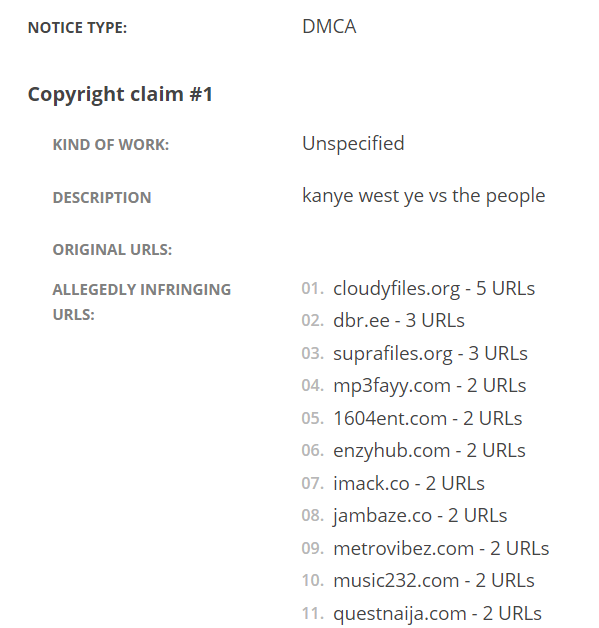[Most Recent Entries] [Calendar View]
Friday, May 10th, 2019
| Time | Event |
| 8:23a | Lumen Database Restricts Access to DMCA Notices But Plans to Expand
Thanks to projects like Google’s Transparency report, however, much-needed light can be shone on this murky area. Users of Google’s service can see almost every detail of a copyright claim but when it comes to accurate research, it’s necessary to visit the Lumen Database, a research project that hosts millions of notices submitted by some of the biggest Internet companies. The resource has become an essential tool for researchers and reporters interested in the cease-and-desist landscape. However, new changes at the resource will mean that the majority of users will now have less initial access to data. In a nutshell, takedown notices presented in Lumen’s database will no longer list the precise URLs targeted by copyright holders. Instead, as the image below illustrates, the notices only list how many URLs were targeted at specific domains.  As is clear from the above, Lumen has removed the specific URL details, which are absolutely crucial if one is to even begin researching the effects of a particular takedown notice. However, on every redacted notice is a hyperlink which presents a system through which it is possible to get an unredacted copy. Regular users wanting to properly research a notice now have to enter their email address to receive a single-use link to view it in full. However, it now transpires that researchers and journalists will be able to obtain a special login to the Lumen Database that its operators hope will provide an experience that’s largely unchanged. That means we’ll continue to bring news on interesting takedowns and report on various trends. That being said, the bigger question is why Lumen has taken this decision. Lumen project manager Adam Holland informs TorrentFreak that it’s all about expanding and improving the service. “Lumen wants to remain a vibrant and valuable feature of the landscape with respect to research, journalism, and public awareness around takedown requests. We believe that we have been successful at doing this over the years and that some great work has come out of, or been predicated on, our data,” Holland says. “But we also feel that it’s both possible and necessary for Lumen to continue to grow and improve. One obvious way in which to do so is to expand the number and type of notices we receive, as well as the range of institutions from which we receive them. We’ve heard from some companies that although they’d like to share notices with us, for a variety of idiosyncratic reasons, they don’t feel that they can do so under the current Lumen schema.” Sensitivity over the amount of information made available by Lumen under default settings will also play an important role as the platform expands. Holland says that DMCA complaints will form just part of the project moving forward, with other forms of takedown notices from all over the world augmenting the database. “We wish to be conscious of the concerns of those sending this broader variety of notices,” he says. As readers will probably recall, the Lumen project has previously been subjected to criticism by copyright holders. We asked Holland if this had played a part in the decision to redact notices for more casual users of the resource, who some allege may have used it to obtain links to infringing content. “Our traffic metrics simply don’t bear out any suggestion that the database is a viable tool for those seeking access to infringing or unauthorized content. But, we have always endeavored to strike a balance,” he explains. “We think that the new framework allows the research community to stay informed while in no way compromising research done with the database. It also — importantly — reduces the significant workload associated with database maintenance, which will free up Lumen staff to do more productive things.” We put it to Holland that there will probably be some members of the public who won’t enjoy jumping through additional hoops to gain full access to notices. However, he says that Lumen doesn’t really have a good sense from its traffic volumes how many people use the resource for specific reasons. But while reduced access will probably be disappointing to some, there are those who see this development as a double-edged sword. TorrentFreak spoke with a representative from an anti-piracy company who told us that less visibility for URLs will be welcomed by his clients. “As a DMCA agent for copyright owners, I can say that Lumen and its predecessor Chilling Effects have long been seen as making a mockery of Google’s takedown procedure – why delist search results if those same results are all still listed in a notice linked at the bottom of the page?” he said. “But I appreciate that the DMCA process can be and has been easily abused, so it’s important to have some kind of ability to check on potential censorship and/or erroneous takedowns. “So while my clients will surely welcome a change that makes it trickier to access infringing material, I share the concerns of those who may feel that this places obstacles in the way of legitimate research and accountability.” Finally, it’s worth noting the large effort expended by the Lumen team to keep the project going. The platform is currently receiving up to 70,000 notices per day (mostly filed under the DMCA) with many requiring redactions to preserve privacy. These can be handled automatically but Holland explains that manual redactions take place frequently, with a single notice potentially taking 20 minutes or more to process. Lumen kindly provided a list of companies and institutions that contribute (or have contributed) to the database. Any parties interesting in joining this group are invited to contact the project. — Automattic/Wordpress Counterfeit Technology The Internet Archive Kickstarter Medium Periscope PGPSMedia [not currently sending] Proxy.sh Reddit [not currently sending] Stack Exchange Stripe [not currently sending] Tucows Tuebl [not currently sending] UC Berkeley – Infosec and policy UC Berkeley – California Digital Library UC Berkeley -Open Computing Facility Vimeo Wikia Wikipedia/Wikimedia YouTube Source: TF, for the latest info on copyright, file-sharing, torrent sites and more. We also have VPN reviews, discounts, offers and coupons. |
| 5:13p | ‘YouTube Content-ID Abusers Could Face Millions of Dollars in Damages’
The Montreal-based video production company has been around for well over a decade and continues to expand its viewership, despite fierce competition. While WatchMojo owes a lot of its success to YouTube, the company is also growing increasingly frustrated with rampant copyright abuse on the platform. We’re not talking about people who steal their content, but about companies that unlawfully claim their videos. These complaints are far from new and we have highlighted these issues repeatedly over the years. However, when a channel the size of WatchMojo sounds the alarm bell, people should pay attention. This includes abusive rightsholders, which could be liable for millions of dollars in damages. But let’s start with the basis for the recent uproar. Last weekend WatchMojo’s CEO Ashkan Karbasfrooshan published a video in which he exposed some of the worst Content-ID abusers. The video provides several examples of companies that claimed WatchMojo content which, according to the channel, is protected under fair use. For example, when WatchMojo published a video commenting on an Avengers movie trailer, an outfit called Hexacorp (which does business as Orfium) claimed it, arguing that the trailer’s music was used without permission. Hexacorp represented Ramen Music, which licensed the track to Marvel, but apparently, WatchMojo wasn’t allowed to show it. WatchMojo disagreed and protested the claim citing fair use. After all, the trailer and music were clearly used for commentary purposes. This worked and Hexacorp eventually let the claim go, but many other channels with less legal knowledge simply accepted the claim, allowing Hexacorp to monetize their videos. What plays a major role here is that protesting Content-ID claims may eventually lead to copyright notices. These notices can result in “strikes” which can then cause people to lose all content in their YouTube channels. That’s not a risk many channels want to take.
TorrentFreak spoke to WatchMojo’s CEO who informed us that this is just one of the many examples. Every month they receive hundreds of Content-ID claims across their channels. However, WatchMojo vigorously fights back and prevails on nearly every occasion. Karbasfrooshan notes that Content-ID abusers come in all shapes and sizes. Some stand out in terms of volume but are quick to let go of claims once a channel protests. Others send only a few complaints but protest when channels push back. While there’s no doubt that rightsholders should be able to pursue legitimate claims, WatchMojo believes that many see the system as a revenue-generating opportunity. They simply issue thousands of frivolous claims, knowing that many won’t be protested, even though there are clear arguments for fair use. This means that the rightsholders will scoop up extra revenue with very little expense. After all, most Content-ID claims are automated. In addition, WatchMojo also signals a possible anti-competitive angle. The channel receives a lot of strikes for content from the music company BMG. These, again, often target fair use videos and are sometimes issued globally, even though the rights can only be enforced in certain countries. The full expose is explained in detail in WatchMojo’s video, where Karbasfrooshan highlights that BMG’s parent company, Bertelsmann, also has a stake in ZergNet, which happens to be a direct competitor of WatchMojo on YouTube. “Bertelsmann, through their investment arm BMDI, has invested in our direct competitor ZergNet, whose assets Looper, Nicky Swift and a bunch of others compete with us for the same audience, fighting for the same ad dollars, competing for the same eyeballs,” WatchMojo’s CEO notes.  WatchMojo’s CEO Ash Karbasfrooshan Whether the behavior is anti-competitive or not, the overarching problem is that many rightsholders ‘abuse’ the Content-ID system, willingly or not. According to US case law, they are required to consider fair use when issuing takedown requests, something that doesn’t happen very often it seems. Content-ID is a voluntary system that’s not rooted in law. However, WatchMojo believes that abusive rightsholders are opening themselves up to millions of dollars in potential damages from YouTube channels. One way this could happen is through a class action lawsuit. Karbasfrooshan floated this idea in his initial video which triggered a lot of response from fellow channel operators. The basic idea is that a group of affected channels files a class action suit against an abusive rightsholder, with the goal of obtaining a settlement for unlawfully claimed and monetized videos. In a follow-up video, WatchMojo explains in detail how this would work. What is clear, is that the potential damages are massive. According to a calculation made by the channel, rightsholders earned over $2 billion through unlawfully claimed videos over the past several years.  Whether the calculations hold up or not, it is clear that companies that send out a lot of claims against fair use content could theoretically face substantial damages. This, of course, has to be backed up in court, but according to WatchMojo’s CEO, who has plenty of legal experience, it’s a viable option. “We are now actively exploring taking legal action against a couple of targets where we have built up a lot of evidence of wrongdoing, abuse, and received additional evidence from other channels too,” Karbasfrooshan tells TorrentFreak. For now, WatchMojo is not ready to serve as a representative plaintiff in a class action suit. It hopes that by highlighting the potential risks for copyright holders, the associated companies will do the right thing and properly consider fair use. WatchMojo has complained about Content-ID abuse for quite a while and it believes that some type of legal action against an abuser is inevitable. Whether that’s through a class action suit or not. “It’s a matter of time, if not us, someone will come along and sue and win big,” Karbasfrooshan tells us. WatchMojo’s CEO has spoken to lawyers who, once they were informed about what was going on, were also convinced that some type of legal action is inevitable. “I assure you that once I explained how Content-ID worked vs. copyright law, and then how rightsholders abused it, the general consensus was: ok, these rightsholders are going to get sued,” Karbasfrooshan says. “Now, whether that’s done via a class action suit or a direct lawsuit is a different matter. I think the former is interesting but the latter is practically more likely,” he adds. Still, Karbasfrooshan hopes that lawsuits are not needed to address this. Ideally, copyright holders should change the way they operate and respect fair use, he says. And there’s also a major role for YouTube here. They can make a simple change and whitelist channels that have good standing, so these are not harmed by frivolous claims. “The answer is simple: it’s time for a separate class of channels for those who use the platform in a professional manner,” Karbasfrooshan notes. The latter angle will be discussed in the third episode of WatchMojo’s four-part series on Content-ID abuse. In addition, the channel will also launch “The FU Show”, where it will break down and discuss fair use (FU) issues in regards to content claims. Needless to say, these videos are very informative, and there’s something in there for channel operators as well as copyright holders. Source: TF, for the latest info on copyright, file-sharing, torrent sites and more. We also have VPN reviews, discounts, offers and coupons. |
| << Previous Day |
2019/05/10 [Calendar] |
Next Day >> |

 With over 20 million subscribers of its main channel and over 30 million over its entire network,
With over 20 million subscribers of its main channel and over 30 million over its entire network,